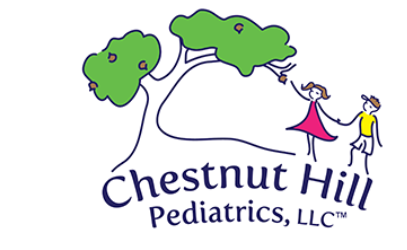Health Topics
- Acetaminophen is very helpful for fever and pain. Please do not use acetaminophen for infants under four months of age without talking to our office first.
- Acetaminophen may be given every 4-6 hours
- Infant drops and the children's syrup may have very different concentrations. Please only use the dropper provided with the infant drops to measure the infant dose.
- Many over-the-counter cold and cough preparations also contain acetaminophen. Use of these products along with an acetaminophen preparation may result in a dangerous overdose.
- Acetaminophen is also available as a rectal suppository for use in children who refuse to take medicine by mouth or who are vomiting. The brand name is Feverall, and it is available in most pharmacies. Please use rectal acetaminophen only on the recommendation of our office.
| Weight | Dose | Infant Drops 160mg/5ml |
Children's Syrup 160mg/5ml |
Chewables 80mg | Chewables 160mg |
| 6-12 lbs | 40 mg | 1.25 ml | |||
| 12-17 lbs | 80 mg | 2.5 ml | 2.5 ml | ||
| 18-23 lbs | 120 mg | 3.75 ml | 4 ml | ||
| 24-35 lbs | 160 mg | 5 ml | 5 ml | 2 | 1 |
| 36-47 lbs | 240 mg | 7.5 ml | 3 | 1 ½ | |
| 48-59 lbs | 320 mg | 10 ml | 4 | 2 | |
| 60-71 lbs | 400 mg | 12.5 ml | 5 | 2 ½ | |
| 72-95 lbs | 480 mg | 15 ml | 6 | 3 | |
| 95+ lbs | 640 mg | 20 ml | 8 | 4 |
FAQ
Related articles & topics
FAQ
Related articles & topics
- Common questions about ADHD treatments
- Caring for pediatric ADHD patients through telehealth
- Preparing your kids for the new school year during COVID-19
- New treatment guidelines for complex ADHD
Recommended reading
- ADHD: What Every Parent Needs to Know, American Academy of Pediatrics, 2011
- Taking Charge of ADHD, Russell Barkley, 2013
Other resources
- Children and Adults with Attention-Deficit/Hyperactivity Disorder (CHADD)
- Learning Disorders Online
- Understanding ADHD: Information for Parents
- Families Ties can set up 1:1 Parent support match (1-800-905-TIES)
Books About Puberty
For Girls:
- The Care and Keeping of You: The Body Book for Girls, by American Girls and Norma Bendell
- A Girl's Guide to Becoming A Teen, by the American Medical Association
For Boys:
- A Boy's Guide to Becoming A Teen, by the American Medical Association
- It's Perfectly Normal: Changing Bodies, Growing Up, Sex, and Sexual Health, by Robie H. Harris and Michael Emberley
Books For Parents
- Getting to Calm: Cool-Headed Strategies for Parenting Tweens + Teens, by Laura S Kastner Ph.D. and Jennifer Wyatt
- Positive Discipline for Teenagers, Revised 3rd Edition: Empowering Your Teens and Yourself Through Kind and Firm Parenting, by Jane Nelsen and Lynn Lott
- Uncommon Sense for Parents with Teenagers, by Michael Riera
- Parent’s Guide to Building Resilience in Children and Teens: Building Resilience, by K Ginsburg and M Jablow
- Parent’s Guide to Understanding Teens’ and Tweens’ Digital World: Cybersafe, by Gwenn Schurgin O’Keeffe
Websites for Teens
- Center for Young Women's Health
- Young Men's Health
- Information about dating abuse: Dating Abuse Stops Here
Websites for Parents
FAQ
Related articles & topics
- Asthma & COVID: Four things families need to know now
- Predicting and preventing asthma exacerbations in children
- A lifeline for families with asthma
Additional resources
- Understanding asthma (English)
- Understanding asthma (Spanish)
- Asthma triggers
- How to use an inhaler with spacer and mouthpiece
- How to use an inhaler with spacer and mouthpiece (en español)
- How to use an inhaler with spacer and mask
- How to use an inhaler with spacer and mask (video)
- Cómo usar un inhalador con espaciador y mascarilla (video)
- How to use a nebulizer with facemask (video)
- Inhaled steroid FAQ
- How to use a peak flow meter (video)
Each year, over 2 million people are injured and over 2000 children die from automobile accidents in the U.S.
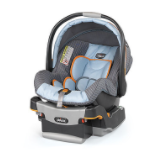
Rear Facing Car Seats: Ages 0-2 years
The American Academy of Pediatrics recommends using a rear-facing seat until your child reaches age 2, or until they reach the maximum height AND weight for their seat.
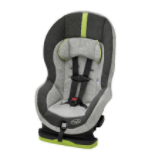
Forward Facing Car Seats:
The American Academy of Pediatrics recommends continuing to use your car seat with a 5-point harness for as long as possible. Always read the car seat and vehicle manuals for weight limits.
Some younger children may outgrow the weight or height limit of the forward-facing car seat with a harness but may not be ready to stay seated properly in a booster seat using the lap and shoulder belt. If this is the case, look for a car seat with a higher weight or height limit.
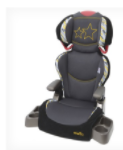
Booster Seats:
Although state law in Massachusetts states that children should be in a booster seat until age 8 or be over 4 feet 9 inches (57 inches) tall, the American Academy of Pediatrics recommends that children ride in a booster seat until they have reached 4 feet 9 inches tall. Most children will not properly fit in vehicle seat belts without a booster until they are 10-12 years of age. Backless booster seats may be used in vehicles with head-rests and high back seats. Otherwise, boosters with backs are preferred.
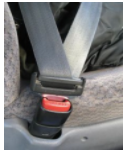
Seatbelts:
The American Academy of Pediatrics recommends that children should ride in the rear of a vehicle until they are 13 years old. The shoulder belt should lie across the middle of the chest and shoulder, not near the neck or face. The lap belt should fit low and snug on the hips and upper thighs, not across the belly. Products that “make the seat belt fit better” are not covered by federal safety standards and should not be used - they can be dangerous.
More Information
- Do not continue to use your car seat if there are visible cracks, it has missing parts or was recalled, or if it has been involved in a moderate to severe crash. In these situations, it’s time for a new car seat! Never leave your child alone in a car. Children can die from heat stroke because temperatures can reach deadly levels within minutes.
If you need installation help: Find a certified CPS technician. Certified CPS technicians and child seat fitting stations are available on the following sites:
- For help with car seat installation locally you can contact the Newton Police Department at 617-796-2112.
- NHTSA (or call NHTSA Vehicle Safety Hotline at 888-327-4236)
- National Child Passenger Safety Certified Technicians (or call 877-366-8154). This site provides information in Spanish and also provides a list of CPS technicians with enhanced training in protection of children with special needs.
- Car Seats: Product Listing for 2021
FAQ
FAQ
Related articles & topics
- COVID-19 and kids: Do you know myth from fact?
- COVID-19 tests: What families should know
- How masks protect against COVID-19: Understanding the science
- Back to school and COVID-19: Tips for divorced parents
- Social distancing: Benefits beyond COVID-19
- Help your kids balance screen time and healthy play during COVID-19
- COVID-19 and vaping: Do you know myth from fact?
- COVID and suicidal thoughts: Help for families
- How Boston Children’s is supporting childcare during COVID-19
FAQ
National Domestic Violence/Abuse Hotline
1-800-799-SAFE, 1-800-787-3224 TDD.
Fever
Fever is a body temperature that is higher than 98.6-100°F. Temperatures below normal are usually not worrisome unless they occur in very young babies.
Fever itself is not an illness, but usually indicates that the body is fighting an infection. Fever is the body’s natural response to infection. In general, an elevated temperature is NOT dangerous. The infection that is causing the fever may or may not be concerning. Fever alone never causes brain damage unless the fever is very high (over 106-107°F).
Fever in a newborn
FAQ
Fever/pain medication
Acetaminophen (Tylenol) dosing
- Acetaminophen is very helpful for fever and pain. Please do not use acetaminophen for infants under four months of age without talking to our office first.
- Acetaminophen may be given every 4-6 hours
- Infant drops and the children's syrup may have very different concentrations. Please only use the dropper provided with the infant drops to measure the infant dose.
- Many over-the-counter cold and cough preparations also contain acetaminophen. Use of these products along with an acetaminophen preparation may result in a dangerous overdose.
- Acetaminophen is also available as a rectal suppository for use in children who refuse to take medicine by mouth or who are vomiting. The brand name is Feverall, and it is available in most pharmacies. Please use rectal acetaminophen only on the recommendation of our office.
| Weight | Dose | Infant Drops 160mg/5ml |
Children's Syrup 160mg/5ml |
Chewables 80mg | Chewables 160mg |
| 6-12 lbs | 40 mg | 1.25 ml | |||
| 12-17 lbs | 80 mg | 2.5 ml | 2.5 ml | ||
| 18-23 lbs | 120 mg | 3.75 ml | 4 ml | ||
| 24-35 lbs | 160 mg | 5 ml | 5 ml | 2 | 1 |
| 36-47 lbs | 240 mg | 7.5 ml | 3 | 1 ½ | |
| 48-59 lbs | 320 mg | 10 ml | 4 | 2 | |
| 60-71 lbs | 400 mg | 12.5 ml | 5 | 2 ½ | |
| 72-95 lbs | 480 mg | 15 ml | 6 | 3 | |
| 95+ lbs | 640 mg | 20 ml | 8 | 4 |
Ibuprofen (Motrin, Advil) dosing
- Ibuprofen is very helpful for fever and for pain. It should not be used in infants under 6 months old.
- Ibuprofen may be given every 6-8 hours
- The most common side effects of ibuprofen are abdominal pain, nausea, and vomiting. Please give the medicine with food to try to prevent these side effects. If your child already has these symptoms, consider using acetaminophen instead.
- Ibuprofen is available in a variety of dosage forms and concentrations. Please be sure to use the dose appropriate for the type of medication you are using. In addition, use only the dropper provided with the oral drops to measure the dosage. This dropper is a very different size than the dropper provided with acetaminophen drops and other droppers available, and improper use could result in over- or under-dosing.
| Weight | Dose | Infant Oral Drops (50 mg/1.25 ml) |
Children's Oral Suspension (100 mg/5 ml) |
Chewables 50 mg |
Chewables 100 mg |
Caplets 100 mg |
| 12-17 lbs | 50 mg | 1.25 ml | 2.5 ml | |||
| 18-21 lbs | 75 mg | 1.875 ml | 4 ml | |||
| 22-32 lbs | 100 mg | 2.5 ml | 5 ml | |||
| 33-43 lbs | 150 mg | 3.75 ml | 7.5 ml | 3 | 1 ½ | |
| 44-54 lbs | 200 mg | 5 ml | 10 ml | 4 | 2 | 2 |
| 55-65 lbs | 250 mg | 12.5 ml | 5 | 2 ½ | 2 ½ | |
| 66-76 lbs | 300 mg | 15 ml | 6 | 3 | 3 | |
| 77-87 lbs | 350 mg | 17.5 ml | 7 | 3 ½ | 3 ½ | |
| 88-98 lbs | 400 mg | 20 ml | 8 | 4 | 4 |
FAQ
Related articles & topics
Fish Consumption Recommendations
For Women Who Might Become Pregnant, Women Who are Pregnant, Nursing Mothers, and Young Children: 2004 FDA/EPA Consumer Advisory
Importance of seafood consumption:
- Fish and shellfish are an important part of a healthy diet and have many nutritional benefits.
- Fish and shellfish contain high quality protein and other essential nutrients, are low in saturated fat and contain omega-3 fatty acids.
- A well balanced diet that includes a variety of fish and shellfish can contribute to heart health and children's proper growth and development. Thus, women and young children in particular should include fish or shellfish in their diets.
- Follow these same recommendations when feeding fish and shellfish to your young child, but serve smaller portions.
Specific recommendations:
- Do not eat Shark, Swordfish, King Mackerel, or Tilefish because they contain high levels of mercury.
- Eat up to 12 ounces (2 average meals) a week of a variety of fish and shellfish that are lower in mercury.
- Five fish that are low in mercury are shrimp, canned light tuna, salmon, pollock, and catfish.
- Albacore ("white") tuna has more mercury than canned light tuna. So, when choosing your two meals of fish and shellfish, you may eat up to 6 ounces (one average meal) of albacore tuna per week.
- Check local advisories about the safety of fish caught by family and friends in your local waters. If no advice is available, eat up to 6 ounces (one average meal) per week of fish you catch from local waters, but don't consume any other fish during that week.
Healthychildren.org - Medical website for parents, created by the American Academy of Pediatrics. Includes general information related to child health, parenting issues, etc.
Kidsdoc Symptom Checker - This tool helps parents make smart decisions on what level of care is needed for your child, and how to provide speedy symptom relief for minor illnesses or injuries you can manage on your own.
- Ibuprofen is very helpful for fever and for pain. It should not be used in infants under 6 months old.
- Ibuprofen may be given every 6-8 hours
- The most common side effects of ibuprofen are abdominal pain, nausea, and vomiting. Please give the medicine with food to try to prevent these side effects. If your child already has these symptoms, consider using acetaminophen instead.
- Ibuprofen is available in a variety of dosage forms and concentrations. Please be sure to use the dose appropriate for the type of medication you are using. In addition, use only the dropper provided with the oral drops to measure the dosage. This dropper is a very different size than the dropper provided with acetaminophen drops and other droppers available, and improper use could result in over- or under-dosing.
| Weight | Dose | Infant Oral Drops (50 mg/1.25 ml) |
Children's Oral Suspension (100 mg/5 ml) |
Chewables 50 mg |
Chewables 100 mg |
Caplets 100 mg |
| 12-17 lbs | 50 mg | 1.25 ml | 2.5 ml | |||
| 18-21 lbs | 75 mg | 1.875 ml | 4 ml | |||
| 22-32 lbs | 100 mg | 2.5 ml | 5 ml | |||
| 33-43 lbs | 150 mg | 3.75 ml | 7.5 ml | 3 | 1 ½ | |
| 44-54 lbs | 200 mg | 5 ml | 10 ml | 4 | 2 | 2 |
| 55-65 lbs | 250 mg | 12.5 ml | 5 | 2 ½ | 2 ½ | |
| 66-76 lbs | 300 mg | 15 ml | 6 | 3 | 3 | |
| 77-87 lbs | 350 mg | 17.5 ml | 7 | 3 ½ | 3 ½ | |
| 88-98 lbs | 400 mg | 20 ml | 8 | 4 | 4 |
The repellents that are proven most effective are DEET and picaridin. Sunscreen/insect repellent combinations are not advised. Repellents should be applied more sparingly and less often than sunscreen. Apply sunscreen before insect repellent so that the sunscreen can bind to the skin.
DEET
- Protects against mosquitoes, flies, chiggers, fleas, ticks
- Safe for children 2 months and up, as well as pregnant women
- Children 2 months and up can use DEET 10-30%, depending on duration of protection that is needed
- Do not apply DEET more than 1 time per day in children
- 10% products last approximately 2 hours
- 24% lasts approximately 5 hours
- 30% lasts approximately 6 hours
- Apply to exposed skin, clothing, or both (but not under clothes)
- To apply to face: apply to palms, rub hands together, then apply to face, wash palms after application
- Do not apply over cuts, wounds, or irritated skin
- Remove repellent with soap and water once it is no longer needed
Picaridin
- Protects against mosquitoes and ticks
- Doesn't irritate skin or damage plastic or clothing
- Products with higher concentrations last longer than those with lower concentrations.
- Choose a product with up to 20% picaridin for adults and 5% to 10% for children over six months.
- Available as Cutter Advanced, Skin So Soft Bug Guard Plus
- Probably similar effectiveness as low concentrations of DEET (2-4 hours)
- No toxicity ever reported in humans (used in Europe/Australia for many years)
- Manufacturer recommends reapplication every 3 to 4 hours
Lemon eucalyptus (also known as PMD)
- Effective against mosquitoes, flies, gnats
- Approved for children 3 years and up
- Available as 65% PMD
- Repel Lemon Eucalyptus Insect Repellent Lotion
- Survivor Lemon Eucalyptus Insect Repellent
- Available as 10% PMD
- Off! Botanical Insect Repellent
- PMD 65% is approximately equivalent to protection from 30% DEET, 10% equivalent to approximately 5% DEET
Citronella
- Not recommended because needs to be reapplied every 1 hour
- Impregnated arm bands have not been proven to work
Learn more at United States Environmental Protection Agency (EPA)
Introduction
- Head lice are tan to grayish-white, 2-3mm long (about the size of a sesame seed), and can be seen moving on the scalp.
- The eggs (nits) are firmly attached to the hair shaft very close to the scalp. Nits vary in color from yellow to brown to white. Nits may be found anywhere on the head, but most commonly are found behind the ears, around the nape of the neck, and on the crown of the head.
- Scalp itching is a result of sensitivity to lice saliva, it may take 4-6 weeks to develop after initial infection.
Transmission
- Lice don’t hop or fly, they can only crawl.
- Transmission usually occurs from direct head-to-head contact or sharing personal items such as combs, brushes, hats, scarves, or coats.
- Lice DO NOT transmit disease.
- Head lice is not caused by poor hygiene/being unclean.
Treatment
A visit to the doctor’s office is usually not necessary First choice of treatment is over-the-counter Nix (permethrin), Rid is another product but Nix is preferable.
- Shampoo hair with regular shampoo, towel dry, apply Nix to damp hair
- Leave in for 10min, then rinse over sink with water that’s not too hot
- Do not use conditioner.
- Use a nit comb after treatment.
- Divide hair into small sections and comb through each one.
- Continue to check hair every 2-3 days for 2-3 weeks to be sure all lice and nits are gone.
- There are professional (but expensive) “nit pickers” who will do this for you if you prefer.
- Repeat application of Nix on day 9
- Scalp itching may persist for a few weeks, even after successful treatment
- If a few live lice are found 8-12 hours after treatment but are moving more slowly than before, do not re-treat. If after 8-12 hours, no dead lice are found and lice seem as active as before, a different treatment should be used.
- These treatments are insecticides, so do not overuse. Please call the office if your child is not responding.
"Natural products"
Some evidence of effectiveness but evidence not as robust as other approved treatments
- Cetaphil Gentle Skin Cleanser
- Apply to hair for 2 minutes then comb through
- Dry with blow-dryer
- Wash out next morning
- Repeat once per week for 3 weeks
- LiceGuard Robi-Comb - should not be used in children with a seizure disorder
- Hair-Clean 1-2-3
Household decontamination
- Clean all items that were in contact with infected person within 24-48 hours before treatment
- Check all family members for live lice or nits close to the scalp.
- Place combs in dishwasher
- Clothes, pillowcases, and other items should be cleaned in HOT water (>140 deg) or machine dried on hot cycle.
- Furniture, carpets, carseats, and fabric can be vacuumed
- Use of insecticides or fumigants on upholstered furniture/carpets/bedding is not necessary and not recommended.
- Items that can't be washed can be bagged in plastic for 2 weeks
Lyme disease is a tick-borne illness caused by the bacteria Borrelia burgdorferi. There are many types of ticks in the United States. However, only deer ticks can transmit Lyme disease. Deer ticks are very tiny, approximately the size of a poppy seed.
Transmission
- Finding a tick on your child does not mean he or she will develop Lyme disease.
- A tick must be attached to a person for at least 36-48 hrs to transmit Lyme disease.
- Even if attached for 36-48 hours, the risk of developing Lyme disease is less than 3%.
Signs of Lyme disease may include
- Fever (usually 3-14 days after bite)
- Expanding red rash (usually within 1 wk, but should be within 1 month of bite). Rash may have a bulls-eye appearance.
- Headache
- Joint aches or swelling
Prevention
- You can prevent some tick bites by wearing light-colored clothes and tucking pants into socks when going into tall grass. As many ticks fall from trees, be especially watchful after going through the woods.
- Apply insect repellent such as DEET to the body. The repellent permethrin can be applied to clothes.
- Please check your children daily for ticks. Deer ticks are no bigger than a poppy or sesame seed. They are most commonly found around the hairline, especially at the nape of the neck and behind the ears. Other common locations are the underarms and groin.
- Pets may bring ticks into the house and should be inspected if they have been outdoors. Treatments to prevent ticks on pets can be obtained from your veterinarian
Tick removal
- If there is a tick attached to your child, pull it straight off with a pair of tweezers. Do not use a twisting motion and try not to squeeze the tick’s body.
- Please do not apply agents to the skin to help remove the tick such as petroleum jelly, rubbing alcohol, nail polish, or soap. Touching the tick with a hot or cold object is not helpful either.
- There will usually be a small black spot left under the skin after the tick is successfully removed.
- Cleanse your child’s bite with alcohol and then apply a first-aid ointment.
- Be sure the tick is dead before you dispose of it.
- Please call our office within 72 hrs for further instructions after removing a tick from your child.
Treatment
- Blood tests for Lyme disease are not usually performed or recommended immediately after a tick bite. This is because the body’s immune system hasn’t produced enough antibodies to detect an infection in the first few weeks.
- We will prescribe oral antibiotics if your child has Lyme disease. We most commonly use doxycyline in children 8 years and older. Children younger than 8 years are usually prescribed amoxicillin. Antibiotics are typically given for a course of 14 to 21 days.
- Lyme disease is completely curable when treated in the early stages.
Additional Resources:
FAQ
Related articles & topics
Lyme disease is a tick-borne illness caused by the bacteria Borrelia burgdorferi. There are many types of ticks in the United States. However, only deer ticks can transmit Lyme disease. Deer ticks are very tiny, approximately the size of a poppy seed.
Transmission
- Finding a tick on your child does not mean he or she will develop Lyme disease.
- A tick must be attached to a person for at least 36-48 hrs to transmit Lyme disease.
- Even if attached for 36-48 hours, the risk of developing Lyme disease is less than 3%.
Signs of Lyme disease may include
- Fever (usually 3-14 days after bite)
- Expanding red rash (usually within 1 wk, but should be within 1 month of bite). Rash may have a bulls-eye appearance.
- Headache
- Joint aches or swelling
Prevention
- You can prevent some tick bites by wearing light-colored clothes and tucking pants into socks when going into tall grass. As many ticks fall from trees, be especially watchful after going through the woods.
- Apply insect repellent such as DEET to the body. The repellent permethrin can be applied to clothes.
- Please check your children daily for ticks. Deer ticks are no bigger than a poppy or sesame seed. They are most commonly found around the hairline, especially at the nape of the neck and behind the ears. Other common locations are the underarms and groin.
- Pets may bring ticks into the house and should be inspected if they have been outdoors. Treatments to prevent ticks on pets can be obtained from your veterinarian
Tick removal
- If there is a tick attached to your child, pull it straight off with a pair of tweezers. Do not use a twisting motion and try not to squeeze the tick’s body.
- Please do not apply agents to the skin to help remove the tick such as petroleum jelly, rubbing alcohol, nail polish, or soap. Touching the tick with a hot or cold object is not helpful either.
- There will usually be a small black spot left under the skin after the tick is successfully removed.
- Cleanse your child’s bite with alcohol and then apply a first-aid ointment.
- Be sure the tick is dead before you dispose of it.
- Please call our office within 72 hrs for further instructions after removing a tick from your child.
Treatment
- Blood tests for Lyme disease are not usually performed or recommended immediately after a tick bite. This is because the body’s immune system hasn’t produced enough antibodies to detect an infection in the first few weeks.
- We will prescribe oral antibiotics if your child has Lyme disease. We most commonly use doxycyline in children 8 years and older. Children younger than 8 years are usually prescribed amoxicillin. Antibiotics are typically given for a course of 14 to 21 days.
- Lyme disease is completely curable when treated in the early stages.
Additional Resources:
If you are planning to travel internationally (to anywhere other than Canada or Western Europe), please call our office AT LEAST 4 WEEKS PRIOR TO YOUR TRIP to discuss the need for vaccines or medications.
When calling the office please leave a message with the country (including the province) you are traveling to, your departure date, and the number of days you will be away. The sooner you call before your departure, the better we will be able to meet your travel needs.
Also, you may visit www.cdc.gov/travel for recommendations on international travel.
Our practice follows the standardized vaccine schedule published by the ACIP.
The Advisory Committee on Immunization Practices (ACIP) consists of 15 experts in fields associated with immunization, who have been selected by the Secretary of the U.S. Department of Health and Human Services to provide advice and guidance to the Secretary, the Assistant Secretary for Health, and the Centers for Disease Control and Prevention (CDC) on the control of vaccine-preventable diseases.
Vaccine Information Statements (VIS)
Books
- Vaccines and Your Child: Separating Fact from Fiction - Paul Offit, MD and Charlotte Moser
Vaccine Safety

